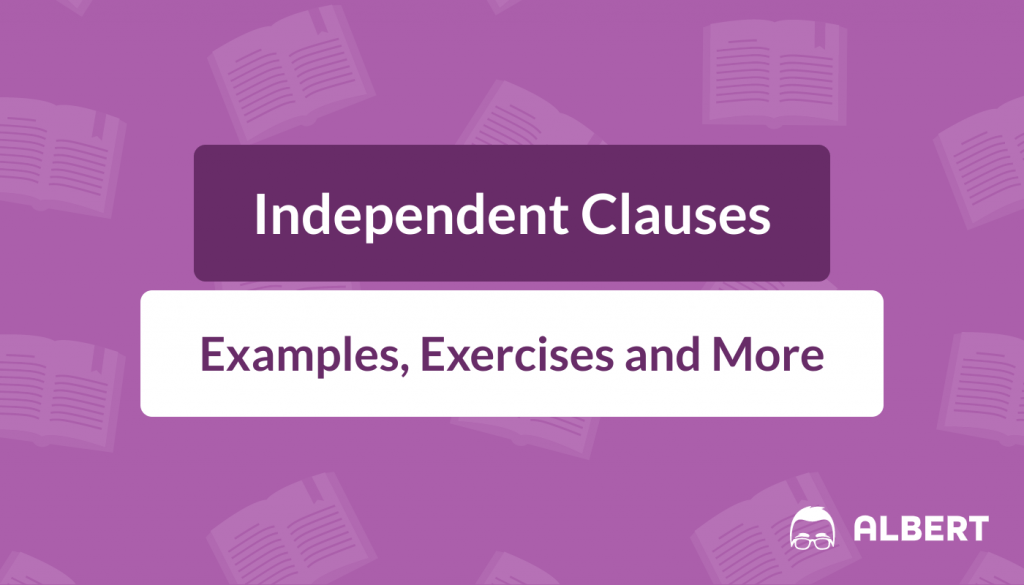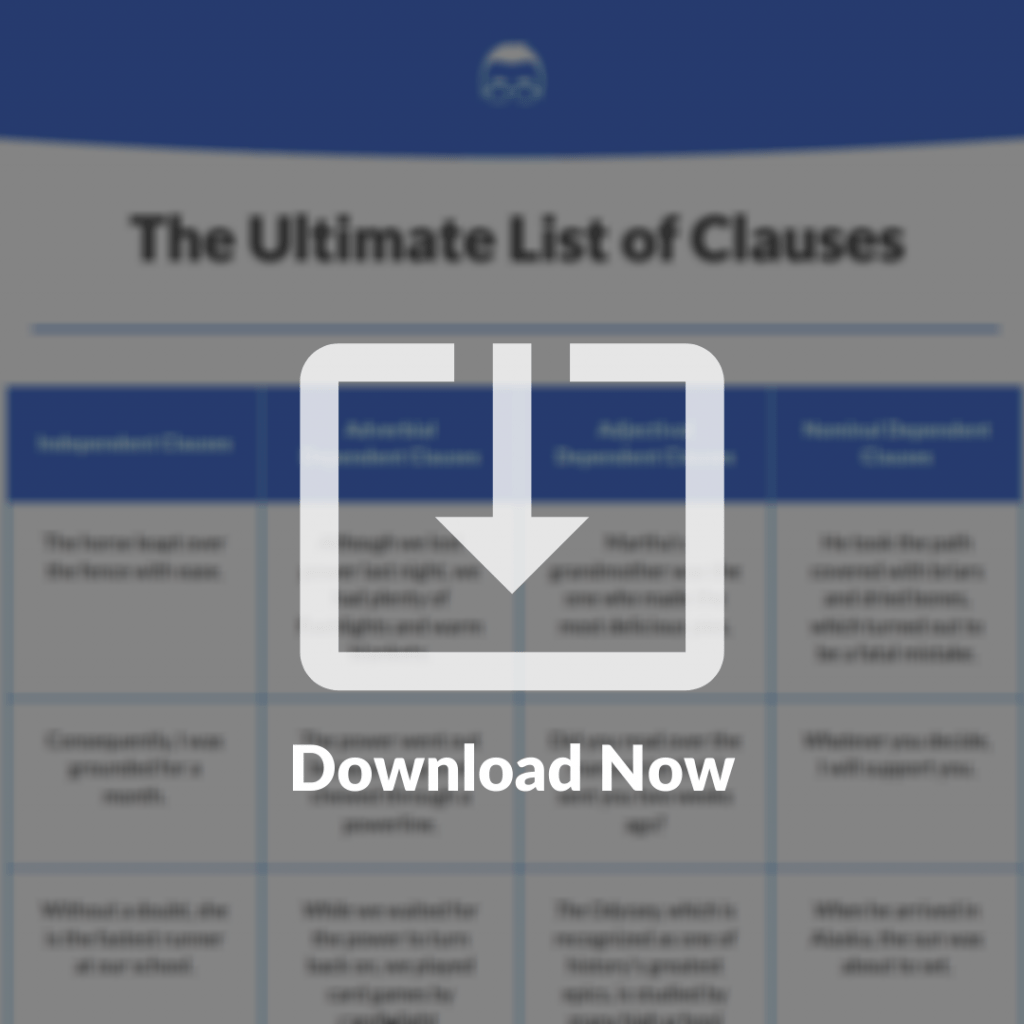Sentences are made up of several layers: there are different parts of speech like nouns, verbs, and adjectives, and there are different parts of a sentence—the subject and the predicate. When parts of speech are combined, clauses are created. When clauses are combined, complete sentences can be created. Every complete sentence must include at least one independent clause, or the combination of at least one subject and one predicate.
When you’re ready, test yourself with a quiz and practice with our high-quality, standards-aligned questions here.
What We Review
The Basics of Independent Clauses
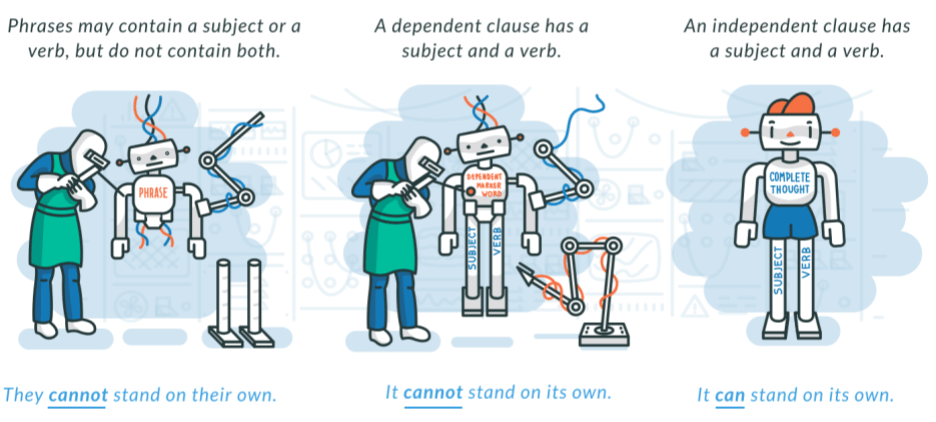
What is an Independent Clause?
An independent clause is the combination of at least one subject and predicate. It expresses a complete thought.
For example:
- The waves crashed onto the sandy shore.
The sentence above is an example of an independent clause because it expresses a complete thought and contains both a subject, the waves, and a predicate, crashed onto the sandy shore.
How are dependent clauses different from independent clauses?
Just as they sound, independent clauses are independent, which means that they do not have to rely on any other clause to create a complete thought. On the other hand, dependent clauses cannot exist by themselves and must be connected to an independent clause in order to create a complete sentence. In other words, they depend on independent clauses as the foundation of the sentence.
There are three types of dependent clauses, and each one depends on the independent clause in a different way.
1. Adverbial Dependent Clauses
- Adverbial dependent clauses modify or describe the main verb of the sentence, which is always found in the independent clause. These clauses start with subordinating conjunctions and answer one of these questions: where, why, how, when, or to what degree?
- For example: We will travel to Disney World this year provided that our plans are not cancelled.
- The dependent clause underlined above modifies the main verb, “will travel” by showing condition or probability.
2. Relative (Adjective) Dependent Clauses
- Relative (adjective) dependent clauses modify or describe a noun which is found in the independent clause. These clauses start with relative pronouns and answer one of two questions: which one, or what kind?
- For example: This is the letter that I gave him.
- In the sentence above, the dependent clause “that I gave him” modifies the subject, “this”, by adding specific details.
3. Noun Dependent Clauses
- Noun dependent clauses can take the role of any noun in the sentence, but if they take any role except that of the subject, they are dependent. These clauses begin with either interrogative pronouns or expletives.
- For example: I do not know if I can pat my head and rub my stomach at the same time.
- In the sentence above, the underlined dependent clause is acting as a noun direct object that answers the question, what?
How do independent clauses connect to other clauses in sentences?
Independent clauses can connect to other independent clauses or to dependent clauses to create more complex and more interesting sentences.
Independent clauses connect to other independent clauses in three ways.
1. Through the use of a semicolon:
If writers would normally divide two independent clauses into two separate sentences, but they decide that they want to show a closer relationship between the two clauses, writers would use a semicolon to connect the two.
For example:
- The popsicle stand had an overwhelming variety of flavors; I couldn’t decide which one to get.

2. With a comma+coordinating conjunction:
If writers want to specify the relationship between two independent clauses further than simply placing them side by side with a semicolon in between, they can use a comma and one of the coordinating conjunctions: for, and, not, but, or, yet, so.
For example:
- The new IPhone was more expensive than I expected, so I had to save for a few more months before purchasing one.
3. With a semicolon+subordinating conjunction+a comma:
Writers can also specify a relationship between two independent clauses by using a semicolon, a subordinating conjunction, and a comma.
For example:
- We had planned to go to the beach today; however, it was raining.
For this particular combination, it can be difficult to remember all of the necessary punctuation. Just remember this formula:
; + subordinating conjunction + ,
Independent clauses can connect to dependent clauses in a couple of ways.
1. If the dependent clause comes first in the sentence, a comma separates it from the independent clause.
If a sentence begins with a dependent clause, this clause is often meant as an introductory phrase to the main idea or the independent clause of the sentence.
Because the subject arrives so late in the sentence, it is necessary to place a comma after the introductory clause to make sure that readers know where the main subject is. The comma acts like a flag waving in the sentence to get the reader’s attention!
Here is how it looks:
- Whether we go to the movies or to the mall, I am happy either way.
2. Other times, writers place the dependent clause after the independent clause.
For example:
- We could not wait to go outside because it had just started snowing.
When the dependent clause comes after the independent clause, no punctuation is needed.
Why do writers connect independent clauses to other clauses in sentences?
While independent clauses do not need to be combined with other clauses to make a complete sentence, writers often connect different clauses together in sentences to add voice and variety to a text. If every sentence was made up of only one independent clause, readers would probably fall asleep from boredom! It would sound like this:
The sun shone through the leaves onto the forest floor. Squirrels chattered from the branches. Birds sang pretty songs. Butterflies floated from flower to flower.

Even though this snippet includes some imagery to make it more interesting to read, it feels static and boring because every sentence is written the same.
However, this same snippet can be easily transformed into something much more engaging by simply combining these clauses with one another:
As the sun shone through the leaves and onto the forest floor, squirrels chattered from the branches. Butterflies floated from flower to flower while birds’ songs echoed through the woods.
By changing two independent clauses into dependent clauses and cutting down four sentences into two, the snippet is much more enjoyable to read.
Return to the Table of Contents
3 Tips for Understanding Independent Clauses
Here are some important tips to help you understand Independent Clauses:

Tip #1. Independent clauses must have at least one subject and one predicate
For example:
- Joe prefers to have bananas and peanut butter on his pizza instead of cheese and marinara sauce.
Even though this sentence has an extra long predicate with lots of modifiers, it is still only one independent clause because there is just one subject, Joe, and one predicate.
Tip #2. If a clause begins with a transition word or subordinating conjunction, then the clause is dependent
For example:
- Although Joe has questionable taste in pizza.
Does this clause feel like it is missing something? This clause is not independent because it begins with a transition word, although. This clause depends on another clause in the sentence to make sense, and is therefore an incomplete thought or a fragment without that independent clause.
Here is the sentence rewritten with an independent clause added at the end:
- Although Joe has questionable taste in pizza, he is still one of my best friends.
Now the sentence is complete and the reader is not left confused at the end of the dependent clause.

Tip #3. Independent clauses cannot be connected in sentences by simply using a comma; writers must use either a semicolon, a semicolon + a subordinating conjunction + a comma, or a comma with a coordinating conjunction
For example:
- Owls sleep during the day; foxes sleep at night.
If we used a comma instead of a semicolon in the sentence above, we would be guilty of a comma splice! Thankfully, this grammatical error can be easily avoided by becoming more comfortable with the unusual piece of punctuation–the semicolon.
Return to the Table of Contents
Applying the Basics: Independent Clause Review & Practice
Now that you understand how independent clauses function in sentences, review the anchor chart below and complete the review to fully understand how to use and recognize independent clauses.
The Ultimate List of Clauses
Refer to the graphic below to learn the different types of Clauses:
This list, obviously, does not include all possible examples of clauses; however, it is meant to be used as a guide while identifying sentence clauses.
Independent Clauses Exercises and Review
Now that you know how to identify independent clauses, test your ability to find them in sentences.
Select the independent clause(s) in the sentences below. Remember, an independent clause must have at least one subject and one predicate and express a complete thought.
1. When Donkey comes to visit Shrek in his swamp, Shrek wants to be left alone.
In this sentence, Shrek wants to be left alone is the independent clause. The beginning of the sentence up to the comma is an adverbial dependent clause that answers when Shrek wants to be left alone.
2. Lord Farquaad tries to marry Princess Fiona, but she refuses to do so.
In this sentence, there are two independent clauses that are joined by a comma and a coordinating conjunction. The first independent clause is Lord Farquaad tries to marry Princess Fiona, and the second independent clause is she refuses to do so.
3. Puss in Boots is a skilled fighter; however, his greatest strength lies in his adorable eyes.
In this sentence, Puss in Boots is a skilled fighter is the independent clause that is separate from the dependent clause through the use of a semicolon, a subordinating conjunction, and a comma.
4. When Princess Fiona transforms into an ogre for good, Shrek reassures her that she is beautiful.
In this sentence, Shrek reassures her that she is beautiful is the independent clause. The other clause in the sentence is a dependent adverbial clause because it starts with the subordinating conjunction, when, and modifies the verb, reassures.
5. Fairy tale creatures swarmed Shrek’s swamp after Lord Farquaad banished them from the kingdom.
In this sentence, fairy tale creatures swarmed Shrek’s swamp is the independent clause because it is a complete thought. The other clause in the sentence is an adverbial dependent clause because it begins with the subordinating conjunction, after, and modifies the verb, swarmed.
Pro tip: Remember, independent clauses must contain a subject and a verb and express a complete thought. If a clause begins with a subordinating conjunction, a relative pronoun, or an interrogative pronoun, it is a dependent clause.
For additional practice, check out Independent Clauses content on Albert.
Return to the Table of Contents
Try for Yourself: Independent Clauses Quiz
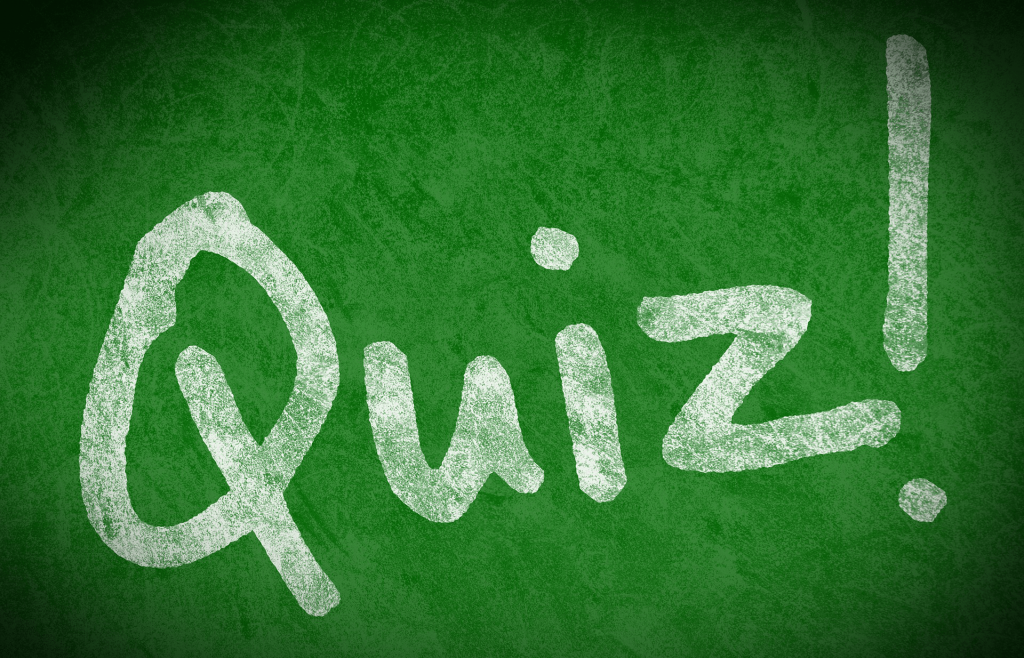
Feeling confident in your understanding of Independent Clauses?
Take this short six-question quiz to see what you’ve learned:
1. Can an independent clause start with a subordinating conjunction?
- Answer: No
- Correct Explanation: That’s right! An independent clause cannot start with a subordinating conjunction because this conjunction makes the clause dependent.
- Incorrect Explanation: Sorry, that’s not right! Remember, an independent clause cannot start with a subordinating conjunction because subordinating conjunctions make clauses dependent.
2. Can you connect two independent clauses together using only a comma?
- Answer: No
- Correct Explanation: That’s right! Independent clauses cannot be connected by only using a comma. Writers must use either a comma and a coordinating conjunction, a semicolon + a subordinating conjunction + a comma, or replace the comma with a semicolon.
- Incorrect Explanation: Sorry, that’s not right! Remember, Independent clauses cannot be connected by only using a comma. This is a grammatical error called a “comma splice”. Writers must use either a comma and a coordinating conjunction, or replace the comma with a semicolon.
3. In this sentence, is the underlined clause independent or dependent?
Whenever we go to the beach, I look for dolphins.
- Answer: Dependent
- Correct Explanation: That’s right! The underlined clause is dependent because it begins with a subordinating conjunction and does not express a complete thought.
- Incorrect Explanation: Sorry, that’s not right! Remember, independent clauses cannot start with a subordinating conjunction, and independent clauses must express a complete thought.
4. In this sentence, is the underlined clause independent or dependent?
The quarterback launched the football across the field, but the wide receiver was unable to catch it.
- Answer: Independent
- Correct Explanation: That’s right! The underlined phrase is independent for two reasons: first, it expresses a complete thought, and secondly, it is connected to another independent clause through the use of a comma and a coordinating conjunction.
- Incorrect Explanation: Sorry, that’s not right! Remember, independent clauses express a complete thought and can be combined with other independent clauses through the use of a semicolon, a semicolon+subordinating conjunction+a comma, or with a comma+coordinating conjunction.
5. In this sentence, is the underlined clause independent or dependent?
His charcoal drawing of a horse should have won first place; however, an oil painting of a flower vase won instead.
- Answer: Independent
- Correct Explanation: That’s right! In this sentence, the underlined phrase is independent because even though it begins with a subordinating conjunction, it still expresses a complete thought and could stand on its own without the help of the rest of the sentence.
- Incorrect Explanation: Sorry, that’s not right! Remember, independent clauses express a complete thought and can be combined with other independent clauses through the use of a semicolon, a semicolon+subordinating conjunction+a comma, or with a comma+coordinating conjunction.
6. In this sentence, is the underlined clause independent or dependent?
We will make it on time if we hurry.
- Answer: Dependent
- Correct Explanation: That’s right! The underlined clause is dependent because it begins with a subordinating conjunction, it modifies the verb, and because it cannot stand on its own as a complete thought.
- Incorrect Explanation: Sorry, that’s not right! Remember, to be an independent clause, the clause must be able to stand on its own as a complete thought.
For additional practice with Independent Clauses, check out our practice on Albert: Independent Clauses.
Return to the Table of Contents
Teacher’s Corner for Independent Clauses
Our students may be able to recognize a complete sentence when they see one, but they might not be able to explain exactly what makes a sentence complete. Some students genuinely struggle to write in complete thoughts, and have difficulty understanding why their sentences are fragmented.
A clear understanding of both independent and dependent clauses is essential for growing confident writers. The Common Core English Language Progressive Skills Chart is a great tool for showing teachers at what point individual students should start learning various skills based on their prior knowledge.
For specific standards on the different types of clauses including independent clauses, check out the Common Core State Standards website.
Albert’s Independent Clause Practice is a helpful tool for students learning how to recognize these clauses and tell them apart from dependent clauses. Once it comes time to assess students’ understanding, Albert also provides teachers with cumulative assessments and smaller topic quizzes that can be used to assess student learning and progress on each skill.
Summary for Independent Clauses
Independent clauses are made by combining at least one subject and predicate. They express complete thoughts.
Independent clauses connect to other independent clauses in three ways:
- Through the use of a semicolon
- With a comma+coordinating conjunction
- With a semicolon+subordinating conjunction+a comma
Be sure to check out our grammar course for more Independent Clause practice.
You can also access over 3,400 high-quality questions that address nearly every grammatical concept.
Need help preparing for your Grammar exam?
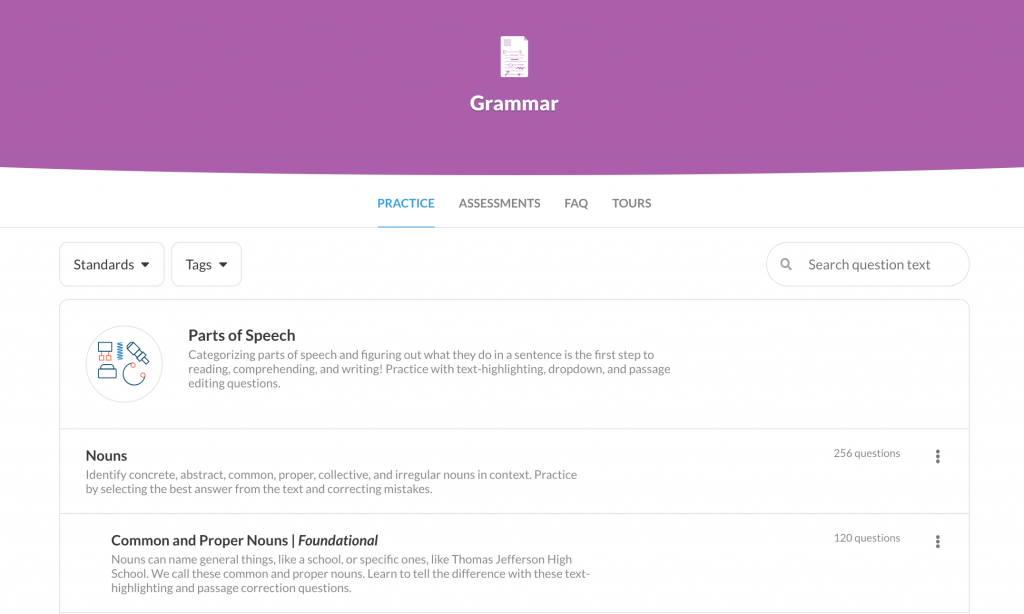
Albert has hundreds of grammar practice questions with detailed explanations to help you master concepts.

